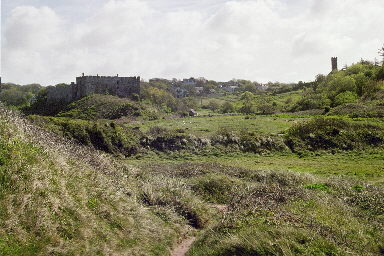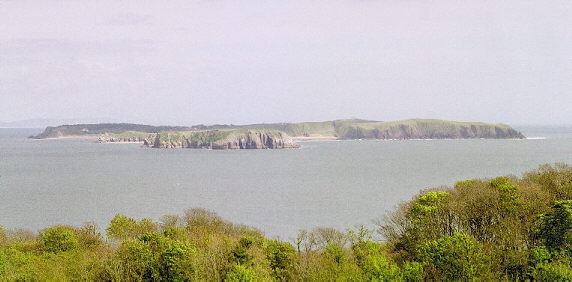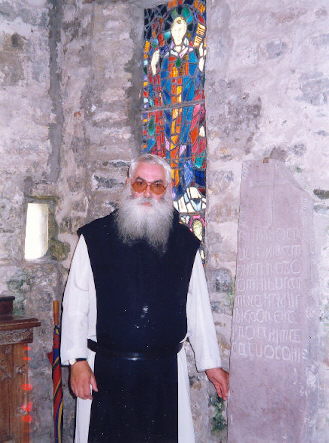The Mystery of the Monastery -
St. Pyr in Manorbier
By Karen Pereczes
As appeared in Pembrokeshire Life magazine. Copyright Karen Pereczes 2005.

Manorbier Castle and St. James' Church (before the tower was painted white).
The
church of St.
James at Manorbier is, in itself, a wonderful piece of 12th century
Norman architecture, though the foundations are ancient and unknown. The
circular churchyard is certainly a characteristic of earlier sites.
Victor
Milgate has been the vicar at St. James' church for the past 18 years. He
says, "I feel that Manorbier is an important pre-Christian site. King's
Quoit cromlech tells us that the area was a sacred place in the Neolithic
period."
Although the site has a long history as a sacred place, there does not exist any early authoritative account of the church. It stands in an idyllic and peaceful setting, overlooking the beach and castle, which Gerald of Wales once described as 'the most pleasantest spot in Wales', and I have to agree with him. But there is much more to this place than first meets the eye...
Brother
Gildas is a Cistercian monk and historian of Caldey Island, where he has lived
for the past twenty years. He believes that the church itself is on part of
the site that was once a large Celtic monastery in the 6th century,
founded by St. Pyr, and that a community or village may have inhabited the
site of Manorbier castle at the same time.
"Manorbier would have been the big monastic site," says Brother Gildas, "and those leading a rigorous and strict religious discipline would perhaps have gone to Caldey. Cut off from the mainland, islands were ideal places often used for this purpose."
Although
very little is known about St. Pyr, he left such an impression that his name
lingered on. It is from him that the name of Manorbier originates, meaning 'belonging to Pyr'. The Welsh name for Caldey Island is
'Ynys Byr',
meaning 'Pyr's island'. This is significant as it links both Manorbier
and Caldey by name.

Ynys Byr - Caldey Island
St.
Pyr is mentioned in the Life of St. Samson of Dol, which is said to have
probably been written between 600-625 AD. He was the first abbot of Caldey
Island monastery in approximately the 6th century, also referred to
as Byr, Piro and Pyrrhus, and was also the local saint of Manorbier. Following
the death of St. Pyr, St Samson - from the Celtic monastery at Llantwit
Major - later become abbot at Caldey, where he remains
the patron saint to this day.
According
to 'A Historical Tour Through Pembrokeshire', written by the historian and
archaeologist Richard Fenton and first published in 1811, the princely stock
of Gwynvardd - one of the most prevailing clans of the county of Pembrokeshire
- traces itself to Pyr y
Dywrain, meaning 'Pyr of the East'. He was known
as the orient darter - so called from his representing the sun. It is said he
officiated as Hierophant at Caldey, and was perhaps the last of the order.
A
Hierophant was the ancient title bestowed to an initiating priest and
expounder of sacred mysteries - a wise and holy man whose purpose was to bring
the spiritual down to earth.
Unfortunately St. Pyr met a tragic fate, which to this day remains an unsolved mystery. In the Life of St. Samson of Dol is a story of St.Pyr, which says,
'One dark night this same Piro in an unseemly drunken bout, as they say - which makes matters worse - wandered alone into the precincts of the monastery and fell into a deep well. He raised a shout of distress, but when he was rescued from the water by the monks he was almost dead, and so he died that night.'
The
questions, for you would-be detectives out there, are: Which monastery did he
come back to... Manorbier or Caldey? Where is St. Pyr buried? Was he murdered after he had been
given intoxicating liquor? And,
if so, whodunit?
Some monasteries during the 6th century were reverting back to their Pagan origins. It is plausible that the monastery at Manorbier was reverting either from Christianity to Paganism, or vice versa. Did Pagans ritually sacrifice St. Pyr? Or was he murdered by Christians?
It is surprising that St. Pyr did not leave behind any evidence of his existence, or that of the monastery. There are a few reasons why this should be the case... it could have been destroyed by those later opposed to a Pagan religion, or perhaps he was a private individual of quiet contemplation and solitude who possibly lived as a hermit for a while - as St. Govan did in the same era. Another explanation is that, in those times, very little was written down and knowledge was passed on in the oral tradition of stories and songs by the Bards.
At some time during the fourth century AD, an Irish tribe known as the Deisi, from Co. Meath in Ireland, migrated to Pembrokeshire under their leader, Eochaid Allmuir, and established a royal dynasty that was to rule in south-west Wales for some five centuries. They provided the first written records in the form of Ogham stones.
Ogham
was an
alphabet denoted by notches cut into the edge of stone,
which
was usually read from the bottom upwards. While many Ogham stones are found in
or near the vicinity of Celtic churches in Wales, it is an interesting fact
that, in Ireland, there are several examples of Ogham stones found near the
oratory or monastic establishment of a Celtic saint; at St. Manchan's cell
near Dingle in Co. Kerry, for example.
The famous Ogham Stone at Caldey was excavated during the 18th century in the grounds to the south of the Priory, which is believed to occupy the site of the original 6th century monastery. A cross and Latin inscription had been added in order to destroy the paganism of the stone, where it was then buried surrounded by crosses on all sides. A number of stone coffins had also been found in the same area.

Brother Gildas with the Caldey Ogham stone.
Ogham writing seems to have been used for commemorative purposes, bearing the names of those who were considered worthy of commemoration. With this in mind, I wonder what or who the Ogham stone at Caldey was remembering? As it has been dated back to the 6th century, it is possible that it was remembering something that had happened during the life (or death?) of St. Pyr. Whatever it was, its purpose was to remind us of something of great importance.
St.
David's church stands
on a small hill above the village on Caldey Island. The present building, like
the church at Manorbier, is Norman in origin, but the foundations and possibly
parts of the stonework of the nave are said to be those of a Celtic chapel
built in the 6th Century. It was common practise to build places of worship on
sites already sacred to earlier religions. It is quite plausible that the
foundations 'of unknown origin' at St. James' church are from the same era,
although Brother Gildas believes they are even older.
"The
church would have looked very different. It is most likely that it would have
been built using timber and wattle. There wouldn't have been pews and the
walls would perhaps have been highly decorated with murals. The ceremonies
would have been constant, incorporating the many Pagan customs and rituals
associated with early Christianity meeting a Pagan world."
The
Celtic saints, as the early missionaries were known, travelled between Ireland
and Rome or Jerusalem. As
the ancient shoreline at Manorbier would have come much further inland, it is
more than likely that the inhabitants of the monastic site would have been
capable sailors. Indeed, it was easier and much faster to travel by sea than
on land. They may have sailed from Manorbier to Caldey for protection at times
of great tension.
A Celtic monastery would have had a strong community, with a wide range of people that included whole families as well as celibate or consecrated virgins. The religion had Pagan foundations - the core belief was one in which the earth and the elemental spirits that are the essence of nature (Earth, Air, Fire and Water) were worshipped and considered sacred. They believed in an unbreakable spiritual bond between their inner selves, the earth, and a 'central source' of all creation, which we commonly refer to today as God. Ancient Celts had a vast knowledge of the healing and magical properties... of plants, herbs and stones.
Women
would have played a powerful part in a Celtic monastery, and were highly
respected for their wisdom. This probably had something to do with woman's
ability to bring forth new life into the world, as childbirth was seen as a
direct connection with the source of all creation.
"Women
were responsible for handing down many of the spiritual teachings, and the
position of Abbess, as we would call it today, was passed down through
generations. Property, too, was handed down from mother to daughter," says
Brother Gildas.
The
question is - how significant was the Celtic monastery at Manorbier? Did it even exist? It is quite possible that this is a forgotten Celtic site of
huge importance.
Maybe, one day, the mystery will be revealed and the true past of Manorbier uncovered - so that the sacred knowledge of St. Pyr will be remembered...
Related
material:
Caldey Island - Tel: 01834 844453/ 842296. Website: www.caldey-island.co.uk
Boats
to Caldey Island run approximately every 20 minutes, departing from Tenby
harbour from Easter to October; Monday to Friday from 10.00am, and Saturdays
from 11am mid-May to mid-September. The island is closed on Sundays. Crossing time is
about 20 minutes. All
sailings are subject to weather and sea conditions.